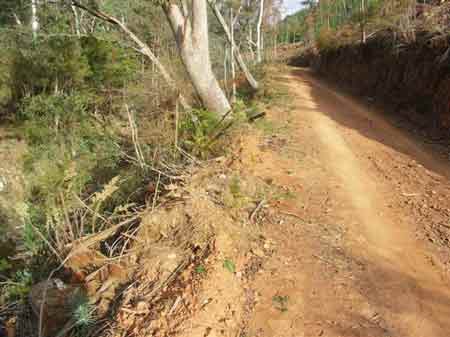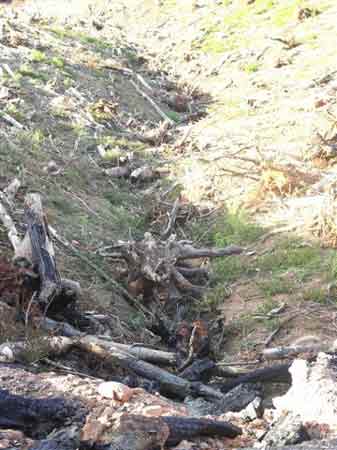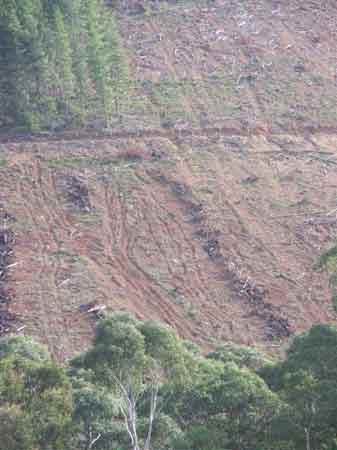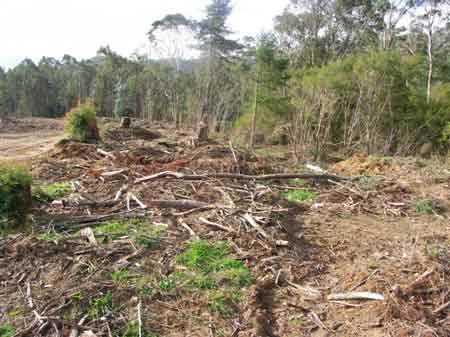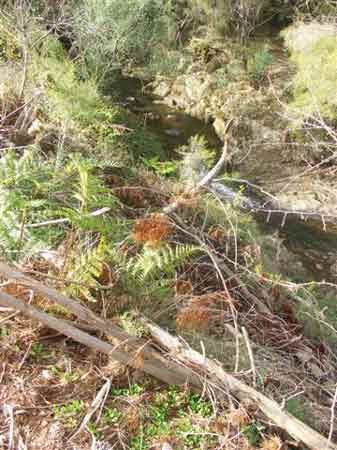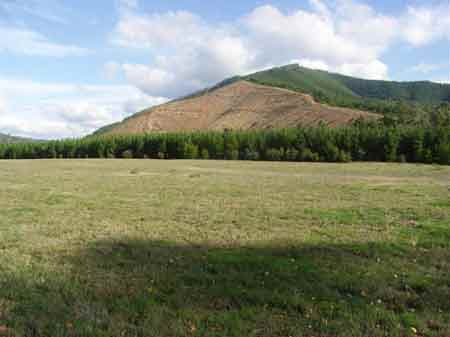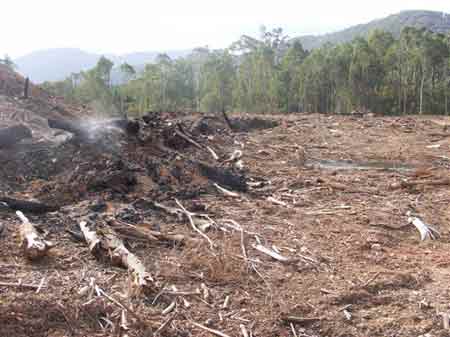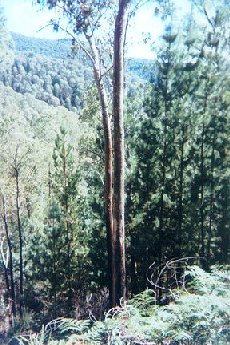Plantation within Carter Holt Harvey (International Paper) area of supply. Plantation within Dominance Industries (Alpine MDF Industries) area of supply. Plantation within D & R Henderson/Monsbent area of supply. North East Victoria Plantation Map here
Image taken Late 2004. Source: Melbourne University School of Resource Management Land & Food Resources. July 2012: The view from a street in Bright.
April 2006: Logging within 20 metres of Morses Creek This plantation was very likely to be aerially sprayed with 2,4,5-T between 1968 and 1977. The Dioxin TCDD may still exist in soil in this plantation. For more historical data on 2,4,5-T click here. For more information concerning the continuing health crisis concerning 2,4,5-T please forward to here. Herbicides Used by Hancock in Pine Plantations - North East Region Victoria
April 2006: Eroding road in close proximity to Morses Creek Proclaimed Water Catchment Area: This plantation area is located in the Ovens River (Wangaratta) Water Supply Catchment.
April 2006: Logging within 5 metres of Morses Creek. MURRAY RIVER SUPPLIES WATER TO YARRAWONGA, COBRAM, BARMAH, ECHUCA , KERANG, PIANGIL, SWAN HILL, ROBINVALE, MILDURA
April 2006: Steep slopes in this plantation. Ex Gold Mine Area: Gold workings most likely occurred in this plantation area during the late 19th Century. Mines may have included Cobbler Mine on Cobbler Gully and White Star Mine.
April 2006: Drainage line cluttered with logging debris.
April 2003: Typical plantation
shot of this plantation. Quite steep slopes and no protection for the
drainage line in this photo.
April 2006: Snig trails on steep slopes near Morses Creek.
April 2006: Riparian zone of Morses Creek.
April 2006: Pine logging no buffers at this point. ôSpecial Investigation: North-Eastern Victoria - Ovens Softwood Plantation Zone. Land Conservation Council 1981. p11 Central Region To the north and east of the Eastern Boundary Fault lies an extensive area of mountainous terrain composed of Ordovician sandstones and mudstones that are less resistant to erosion than the rocks of the south-western region. The drainage pattern is dendritic and the streams are seperated by sharp ridges and spurs. The mountains to the south of Mount Buffalo are typical of this region, which extends east to Mount Beauty and north to Myrtleford. In the north-west around Moyhu and Bobinalwarral the ridges of Ordovician sediments become buried beneath the alluvial deposits of the riverine plain. Within the region, exposures of granitic rocks have intruded into the surrounding Ordovician sediments. Intense heat associated with the intrusions has altered (or metamorphosed) the adjacent sedimentary rocks. The granite outcrops at Mount Buffalo and Mount Emu are extremely resistant, while the surrounding sedimentary rocks which are less resistant have been deeply dissected.
April 2006: International paragliding site with clearfell in background In contrast, the granite in the Pinnacles area to the east of Myrtleford
is more susceptible to weathering and erosion and as a consequence the
terrain in this area is more subdued. A ridge of metamorphic rocks borders
Happy Valley to the east of Myrtleford. Friable reddish and brownish
gradational soils occur on the Ordovician sediments of this region,
while the granitic rocks of Buffalo Plateau and Mount Emu exhibit a
variety of soil types. Stony loams are characteristic of rocky outcrops
while poorly drained sites contain organic loams and peats. Sandy loams
and friable gradational soils are found on the lower slopes of these
intrusions. The less resistant granitic rocks at the Pinnacles and Abbeyard
carry a variety of gradational soils on the upper slopes and a range
of duplex soils at lower elevations. The gradational soils are suitable
for softwoods, but the poorly drained duplex soils are not.
April 2006: Logging in close vicinity to Morses
creek.
|




